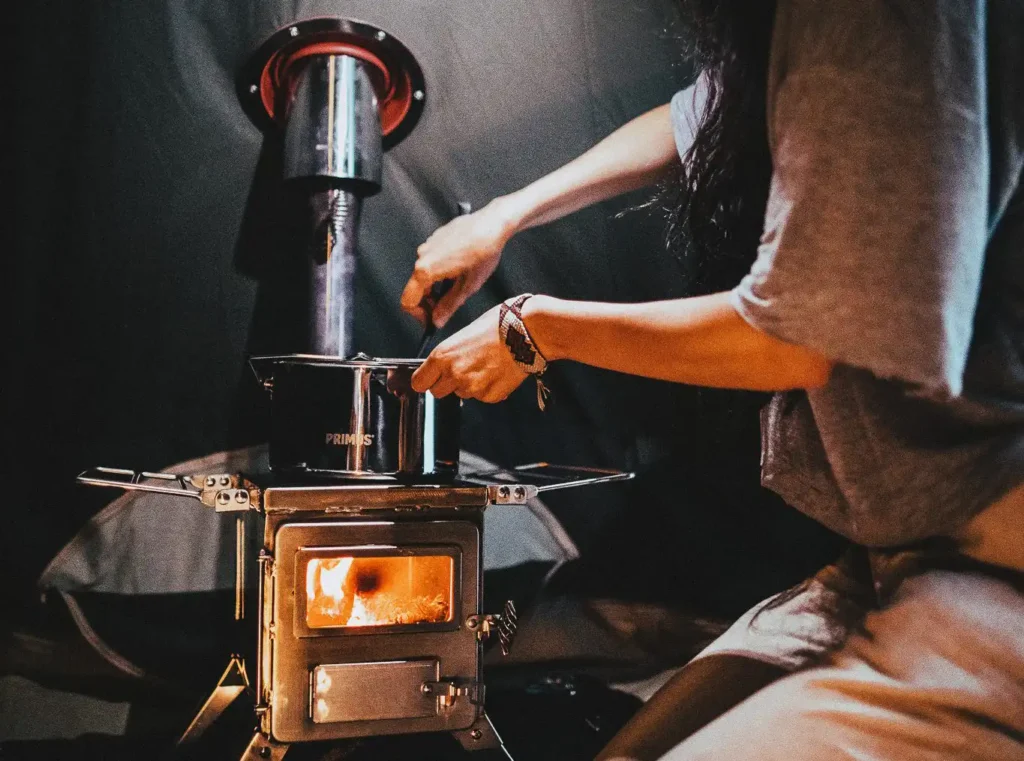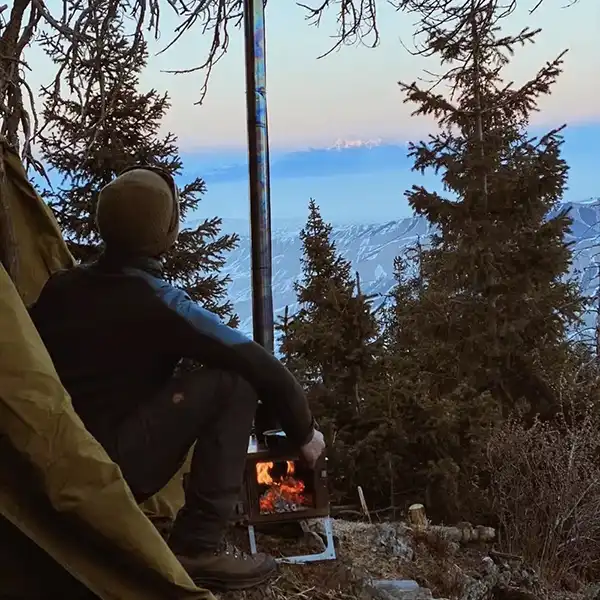As an avid outdoors enthusiast, I’ve learned the hard way that camping is not always smooth sailing, especially when it comes to cooking in the wilderness. Whether it’s battling strong winds, torrential rain, or freezing temperatures, your camping stove can either be your best friend or your biggest challenge in tough conditions. But, with the right stove and knowledge, cooking on a camping stove in any weather is totally achievable. Here’s a step-by-step guide to help you navigate How to Safely Use a Camping Stove in Any Weather.
How to Safely Use a Camping Stove in Any Weather:
Step 1: Choose the Right Camping Stove for the Weather
One of the most important things I’ve learned is that not all camping stoves are created equal, and choosing the right one for your environment can make or break your experience. Over the years, I’ve tried various stoves, and here’s what I recommend based on weather conditions:
Cold Weather Camping:
In freezing temperatures, a lot of campers (myself included) get caught off guard when their stove refuses to work properly. This is because canister stoves rely on gas pressure, which drops in the cold, making them inefficient or completely useless. Here’s what works best in the cold:
- Liquid Fuel Stoves (like the MSR WhisperLite or Primus OmniFuel) are designed to handle cold conditions. These stoves burn liquid fuels such as white gas, kerosene, or unleaded gasoline, and they’re known for their ability to perform even when the temperature drops below freezing.
- Multi-Fuel Stoves are also a great choice in colder climates. They can burn various types of fuel, including propane and white gas, offering versatility if temperatures fluctuate.
- Winnerwell Nomad Wood Stove: For those seeking a sturdy, reliable wood-burning stove, the Winnerwell Nomad stove is an excellent choice for winter camping. This stove can be used in the coldest conditions and provides a source of warmth and heat for cooking, making it ideal for snowstorms or sub-zero temperatures. I’ve used it on numerous winter trips and appreciate how its design helps distribute heat efficiently in the harshest conditions.

Warm Weather Camping:
On the other hand, when you’re camping in warmer weather, you can get away with using a lighter stove that’s more convenient and easy to handle.
- Canister Stoves (like Jetboil or MSR PocketRocket) are ideal for mild conditions. They use small canisters of butane/propane mix, and their efficiency and portability make them great for quick meals in moderate temperatures.
- Liquid Fuel Stoves still work well in warm weather, but they’re often heavier and bulkier. However, I use them in both cold and warm weather for the versatility they offer.
- Winnerwell Titanium Stove: For warm weather and lightweight trips, the Winnerwell Titanium stove is a great choice. This stove is not only incredibly light but also durable enough to handle a variety of conditions. It’s particularly efficient for mild temperatures, as it burns cleanly and doesn’t overheat your cooking area, allowing you to cook comfortably without worrying about excess heat. I’ve used this stove in both mild weather and during moderate hiking trips, and it never disappoints.
Wet Weather & Rain:
When it’s raining, or if you’re camping near water, keeping your stove dry is crucial. Even the best stoves can be problematic if they get wet, so look for stoves that can function efficiently with a windscreen or are designed for such conditions.
Step 2: Know Your Fuel Type and How It Affects Performance
Choosing the correct stove fuel is as important as choosing the right stove. Based on my experiences, here’s how different fuels perform in varying weather conditions:
- Canister Fuels (Butane/Propane): In mild temperatures, this fuel type works great. Butane burns well when it’s above 40°F (5°C), but when temperatures drop, it loses pressure, and your stove won’t work as efficiently or at all. In colder weather, you can try keeping the fuel canister warm by placing it inside your jacket or using a canister stabilizer.
- White Gas (Liquid Fuel): This is the go-to fuel for winter camping. It burns hot and reliably, even in sub-zero temperatures. In my experience, liquid fuel stoves like the MSR WhisperLite are indispensable in winter camping conditions.
- Alcohol Fuels (Ethanol or Methanol): Alcohol stoves are light and compact but are best suited for low-wind, dry conditions. They don’t provide as much heat as liquid fuel stoves, so I generally reserve them for short trips or for use in warmer weather.
- Wood-Burning Stoves: For those who want an ultra-sustainable option, wood stoves can be an option when you’re sure there’s an abundance of dry wood around. In my experience, wood stoves can be a hassle in rainy or snow-covered conditions, but they can also make for an incredibly cozy camping experience if you’re in the right area.

Step 3: Set Up Your Stove in the Right Location
Where you place your stove can be the difference between a successful cooking experience and a potentially dangerous one. I’ve had my fair share of incidents where I rushed the setup in harsh conditions, only to regret it. Here’s what I’ve learned:
- Flat, Stable Ground. Always set your stove up on a stable surface, free from uneven rocks or logs that could tip the stove over. Trust me—I’ve seen it happen, and it’s a nightmare when a hot pot of soup spills on your gear.
- Wind Protection: Wind can blow out your flame or significantly reduce the stove’s efficiency. Always try to position your stove behind a natural windbreak like a rock or large tree, or use a purpose-built windscreen to keep the flame going strong.
- Rain/Snow Protection. When camping in wet weather, set your stove up under a tarp or inside a sheltered area like a vestibule if you’re using a tent. If you’re camping in a storm, make sure your stove is covered when not in use to avoid water getting into the fuel or burners. When I camp in snowy conditions, I make sure to clear snow from the stove’s base and cover the stove when I’m not using it.
Step 4: Monitor the Weather & Adjust Accordingly
Monitoring the weather is not just important for your stove, but also for your safety. In my early camping days, I didn’t pay enough attention to shifting weather patterns, which led to a few sketchy cooking sessions. Here’s how to stay ahead:
- Windy Conditions: Strong winds can significantly reduce cooking times and, in some cases, make stoves unsafe to use. If you’re in an area prone to gusts, you can try to shield your stove with rocks, trees, or even use a portable windscreen. I’ve personally used a cheap foldable windscreen on multiple trips and it makes a huge difference.
- Rain and Snow: Cooking in the rain or snow can present a real challenge. If you’re planning to cook in a storm, make sure you’ve packed enough backup fuel. As wet conditions will cause your stove to burn fuel faster than normal. Keep your stove covered when not in use, and cook quickly to minimize exposure to the elements.
- Sun and Heat: When it’s hot, dehydration can set in quickly. Cooking outside can heat up the area around you. Make sure you have plenty of water, and try to cook during cooler parts of the day. In hot conditions, it’s easy to overcook food. So keep a close eye on your stove and food to avoid burning or drying out.

Step 5: Stay Safe While Cooking
Cooking in the wilderness is as much about safety as it is about making a meal. I’ve had a few close calls and learned the hard way to always follow safety precautions:
- Never Leave the Stove Unattended: This is a golden rule. I learned this the hard way when a gust of wind blew out my stove and nearly caused a small fire. Even in dry conditions, leaving your stove unattended can lead to accidents.
- Check for Gas Leaks: Always check your stove for gas leaks before use, especially in cold or wet conditions. If you smell gas, stop immediately, disconnect the fuel, and inspect the connections before proceeding.
- Keep Fire Extinguishers or a Fire Blanket on Hand: You can never be too prepared. A fire extinguisher or a fire blanket is essential when cooking in extreme weather, especially during high winds.
- Turn Off the Stove After Use: Once you’re done cooking, make sure your stove is completely turned off. It’s easy to forget in the hustle of packing up camp, but a forgotten stove is a potential hazard.
Step 6: Pack Smart and Be Prepared for Anything
Finally, always pack for the unexpected. You may think you have everything covered, but weather can turn on a dime. I’ve learned to always pack extra fuel, just in case the weather drains my fuel faster than anticipated. A backup stove or portable power source isn’t a bad idea either.
Conclusion: How to Safely Use a Camping Stove in Any Weather
Camping and cooking in any weather can be a rewarding and fulfilling experience if you prepare properly. The key to success is choosing the right stove and fuel, setting up in the right spot, adjusting for the elements, and prioritizing safety at every step. With these tips and lessons learned through experience, you’ll be able to enjoy hot, hearty meals in any weather, no matter how unpredictable the conditions may be. Whether it’s the Winnerwell Nomad stove in the depths of winter or the Winnerwell Titanium stove on a warm, sunny afternoon. The right gear makes all the difference in ensuring your camping stove adventure is a success.
